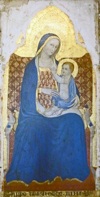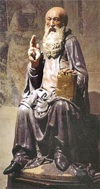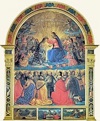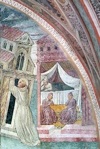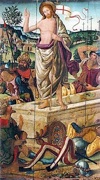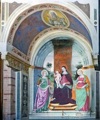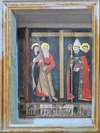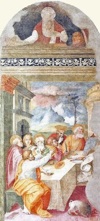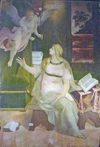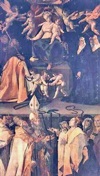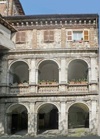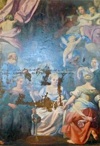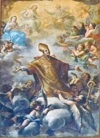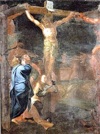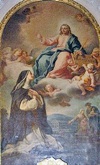

Matteo di Giovannello, il Gattapone (died after 1374)
Two monuments in Narni are attributed to il Gattapone:
-
✴the Rocca di Narni (1367-78, illustrated here), which Cardinal Albornoz commissioned just before his death, and which is variously attributed to il Gattapone, Ugolino di Montemarte (see below) or both; and
-
✴Palazzo dei Priori, which was probably commissioned in 1373-7, when the Orsini held Narni for the papacy.
Ugolino di Montemarte (1325-88)
Ugolino di Petruccio da Corbara, Conte di Montemarte, entered the service of Cardinal Gil Albornoz in 1353 and remained in papal service for the rest of his life. He was primarily a soldier and administrator, but he also became expert in military fortifications. The design and construction of the Rocca di Narni (1367-78), which Cardinal Albornoz commissioned just before his death, is variously attributed to il Gattapone (see above), Ugolino di Montemarte or both
Cola Petruccioli (died 1401)
From Orvieto, moved to Perugia
Two documented panels (1390) in Sant’ Agostino, which depicted SS Fabian and Roch, were signed by Cola Petruccioli and dated by inscription. They no longer survived there by 1898.
[Link to Cola Petruccioli]
Maestro della Dormitio di Terni (ca. 1400)
A number of works that are attributed to the Maestro della Dormitio di Terni survive in Narni. These include this fresco fragment of angels, which was detached from San Domenico and is now in the Pinacoteca.
Maestro di Narni del 1409
This master is named for a panel of the Madonna and Child enthroned (illustrated here), which is dated by inscription to 1409. This panel, which is now in the Musée du Petit Palais, Avignon, seems to have been the central panel of a polyptych in Sant’ Agostino. Most of the surviving frescoes that are attributed to this master and his workshop are in Narni.
Bernardo Rossellino (1409-64)
Bernardo Rossellino, trained as an architect and sculptor in Florence in the 1420s. He was papal architect to Pope Nicholas V (1447-55): according to Giorgio Vasari. he worked on the fortress of Narni (and those of Orvieto and Spoleto) in this capacity in 1449.
Lorenzo di Pietro, il Vecchietta (died 1482)
Il Vecchietta,was an accomplished painter, sculptor and miniaturist. Like other Sienese artists, he benefitted from the election of the Sienese Pope Pius II in 1458. He probably met Cardinal Berardo Eroli at the papal court, and this connection probably brought him to Narni. His works here include:
-
✴a signed polychromed wooden statue (ca. 1462-3) of St Bernardino of Siena for the Eroli Chapel, San Francesco, which is now in the Museo Nazionale del Bargello, Florence;
-
✴two works from a chapel that belonged to the Compagnia di Sant' Antonio, which are now in the Duomo:
-
•a signed polychromed wooden statue (1475) of St Antony Abbot (illustrated here); and
-
•a panel (ca. 1475) of St Juvenal (attributed); and
-
✴a painted terracotta bust (15th century, attributed) of St Bernardino of Siena, from an unknown location, which is now in the Pinacoteca.
Domenico Ghirlandaio (1449-94)
Ghirlandaio worked at the papal court in Rome and for a number of important clients in his native city. The altarpiece (1486) of the Coronation of the Virgin that he painted for the Observant Franciscans of the Convento di San Girolamo (illustrated here) was hugely influential in Umbria, particularly in Franciscan circles. It is now in the Pinacoteca.
Benozzo Gozzoli (1420-97)
This signed altarpiece (ca. 1499) of the Annunciation, which is also dated by inscription, came from San Domenico. Stylistic considerations suggest that it pre-dates Benozzo’s work at Montefalco in 1450-2. The panel, which is now in the Pinacoteca, has been restored on a number of occasions, most recently in 2002.
Pierantonio Mezzastris (ca. 1430-1506)
Pierantonio Mezzastris painted a series of frescoes (ca. 1470), including the one illustrated here, for what is now the Eroli Chapel, San Francesco. Cardinal Berardo Eroli probably commissioned this work, as well as a fresco (ca.1470) from the lunette of a portal of San Girolamo that is attributed to Mezzastris, which is now in the Pinacoteca.
Antoniazzo Romano (died after 1508)
Antoniazzo is the only known native artist who was prominent in Rome in the late 15th century. This damaged but recently restored panel in the Pinacoteca, which depicts the Resurrection of Christ, is attributed to him. Nothing is known of its original location.
Pier Matteo d' Amelia (ca. 1445-1509)
Pier Matteo d’ Amelia was first documented in 1467, when he was working as a "garzone" (apprentice) of Filippo Lippi on the frescoes of the Duomo, Spoleto. He was called to Rome to decorate the ceiling of the newly-rebuilt Sistine Chapel in 1476, and subsequently secured other prestigious commissions. This fresco (1482) of the Madonna and Child with saints in Sant’ Agostino is attributed to him.
Pancrazio (died ca. 1513) and Rinaldo Jacovetti (died ca. 1528)
Pancrazio Jacovetti was documented in Narni in 1472. Works in Sant Agostino that are attributed to him include this panel (15th century) of standing saints and the fresco in the aedicule on the exterior facade. An icon (15th century) in the Cappella della Consolazione, San Giovenale, which is a copy of the icon in Santa Maria del Popolo, Rome, is attributed to him.
None of the documented works in Narni of his son, Rinaldo, survive.
Torresani Family (16th century)
The brothers Lorenzo and Bartolomeo Torresani were documented in 1523 at Sant’ Agostino, Narni, by which time they were resident in the city.
-
✴The brothers painted the frescoes (ca. 1523-38) in the Cappella di San Sebastiano, Sant’ Agostino, which include this depiction of the Doctors of the Church in the vaults.
-
✴A fresco (1517) of the Madonna and Child in San Giovenale is attributed to Bartolomeo.
-
✴The Compagnia di San Giuseppe commissioned frescoes (1570) of scenes from the Old and New Testaments from Alessandro Torresani, the son of Lorenzo, for their chapel in San Francesco.
Giovanni Francesco Perini (died after 1574)
Perini was documented in Rome in 1523, when he belonged to the team at work in the Vatican Palace following the death of Raphael (in 1520). Only one of his five documented works survive: a damaged altarpiece (1538) of the Last Supper in the Duomo, Amelia. The same cartoon was used for one of the frescoes in the right apsidal chapel of San Domenico, which is now in the Pinacoteca (illustrated here). This fresco and the others in the chapel are thus attributed to him.
From Forlì , based in Rome
Two panels in Amelia were signed by Livio Agresti :
-
✴the Annunciation (1559), now in the Pinacoteca (illustrated here); and
-
✴the Consignment of the Keys to St Peter (1560), in San Giovenale.
Probably fro Northern Italy, worked mainly in and around Narni
Text
Johann Marten Stellaert (died after 1568) and Gillis Congnet (died 1599)
These Flemish artists were documented in nearby Terni in 1567-8. The damaged frescoes (1570) in the vault of the Cappella del Rosario of San Domenico are attributed to them: the inscription giving the date, which was documented in 1872, is no longer legible. The surviving frescoes depict:
-
✴scenes from Genesis, in the vaults (illustrated here); and
-
✴the Annunciation, on the right wall.
Taddeo Zuccari (died 1566) and Federico Zuccari (died 1609)
From Urbino , based in Rome
These brothers moved to Rome at an early age and formed an important workshop that secured the patronage of Pope Paul IV and Cardinal Alessandro Farnese. After Taddeo’s early death, Federico established an international reputation.
-
✴Frescoes (1581) in Palazzo Scotti are attributed to Federico Zuccari.
-
✴Frescoes (16th century) Martyrdom of St Margaret of Antioch on the walls of Santa Margherita are variously attributed to Federico Zuccari or to Antonio Circognani, il Pomarancio (below).
[Temporary link to Taddeo and Federico Zuccari]
Ippolito Scalza (1532-1617)
Palazzo Scotti (1567) is attributed to Ippolito Scalza on stylistic grounds. If this attribution is correct, it was probably the first palace that he designed.
Antonio Circignani, il Pomarancio (1570-1630)
From Città della Pieve, based in Rome
Frescoes (ca. 1606) of four scenes of the Martyrdom of St Margaret of Antioch in Santa Margherita are variously attributed to Federico Zuccari (above) or to Antonio Circognani.
[Temporary link to Antonio Circignani]
Giuseppe Cesari, il Cavalier d’ Arpino (1568-1640)
The Cavalier d’ Arpino was probably the most important artist in Rome during first two decades of the 17th century, when he enjoyed the esteem and patronage of Pope Clement VIII. His altarpiece (early 17th century) depicting the Visitation is on the high altar of Santa Restituta.
Antonio Gherardi (1638-1702)
Antonio Gherardi (born Antonio Tatoti) trained in Rome as a painter and architect under Pietro da Cortona in 1662-7. This altarpiece (ca. 1695) in Santa Restituta, which depicts the Birth of St John the Baptist, and which came from the high altar of the now-demolished church of San Giovanni Decollato di Narni, is traditionally attributed to him (although doubts have been raised about this attribution following its recent restoration).
Girolamo Troppa (died after 1710)
Works in Narni that are attributed to Girolamo Troppa include:
-
✴a panel of St Juvenal in glory, in the Duomo (illustrated here); and
-
✴frescoes in Santa Margherita.
Giacinto Boccanera (1666-1746)
This artist, who was based in Perugia, painted a series of 14 small panels (1728-9) of scenes from Via Crucis for San Girolamo, some of which were signed and dated by inscription. The 11 that survive, which include this one of the Crucifixion, are now in the Pinacoteca.
Etienne Parrocel, il Romano (1696-1776)
This altarpiece (1750) of the Vision of the Blessed Lucy, which is in the church of the Istituto Assistenza Infanzia Beata Lucia di Narni, is signed by Etienne Parrocel and dated by inscription.





